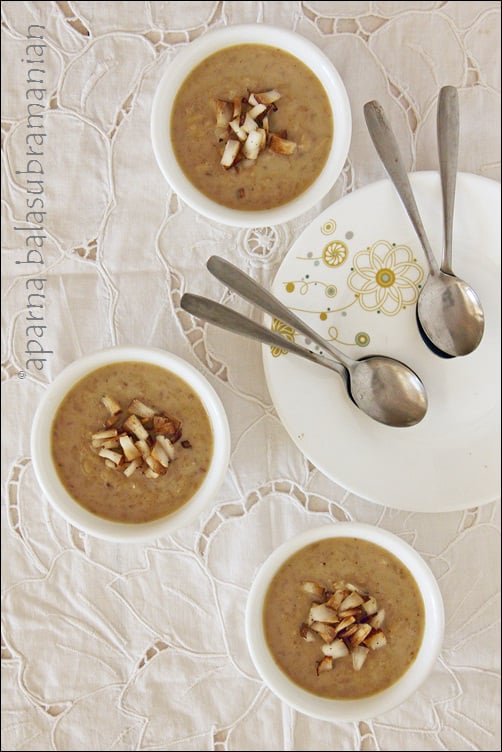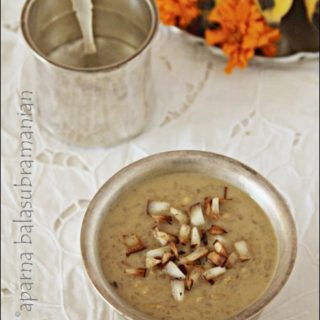
This is my first recipe posting and I thought I would start with something sweet. One of my personal favourites among Palakkad Iyer desserts, our traditional cuisine, is Parippu Pradhaman . Actually, we do not have the concept of dessert, which is served at the end of the meal, as is known in the Western world. In most regional cuisines of India, traditonally a sweet ot sweet dish is preapared for festivities mostly and either served along with the meal, as a stand-alone dish in between mealtimes or sometimes served at tea time like a snack.
In Indian, depending on the region of the country, a very common sweet that is served as festive fare is the Indian equivalent of the rice pudding. In the North this rice pudding is called kheer and in my community we refer to this as “Payasam”
Kheers and Payasam come in many variations and can be milk or coconut based and made with rice, broken wheat, vermicelli, etc and is sweetened with either sugar or jaggery (unrefined form of sugar)
A pradhaman is a payasam(kheer/dessert) from the South Indian state of Kerala and is usually made using jaggery and coconut milk, though it is sometimes made with milk and sugar. A Pradhaman is typically festive fare and usually one of the sweets served at a “Sadhya” (festive meal). The name “Pradhaman” means “the first one” and it is typically the first item served during the Sadhya.

Parippu(lentil) pradhamans can be made using either moong dal or chana dal, or a combination of rice and moong dal.
I usually make this using a combination of moong dal and chana dal, which we like. A Pradhaman is generally a little thicker in consistency than a Payasam/ Kheer. As always, there are as many versions of this dish with minor variations, and this is mine.

Parippu Pradhaman - South Indian Style Lentil, Coconut Milk And Jaggery Pudding
Ingredients
- 1/4 cup moong dal
- 1/4 cup chana dal (bengal gram dal)
- 1 to 1 1/2 cups jaggery powdered ( depending on the sweetness of )
- 1 coconut (for milk)
- 2 tbsps ghee
- 2 tbsps cashewnuts halved/ broken
- 1 - 2 tbsps coconut slivers(optional)
- 1 tsp cardamom powdered
Instructions
- Coconut milk extraction: I'm sure everyone knows this but am including it anyway.
- Add a couple of tbsps of warm water to the grated coconut and blend. Squeeze out the milk- this is the 1st milk. Add just about 1/2 cup of warm water to the residue and blend again. Squeeze out the milk-this is the 2nd milk.
- To make the Pradhaman, start by heating 1 tbsp ghee and fry cashewnuts till golden. Keep aside. In the same ghee, brown the coconut pieces and keep aside.
- Now put the moong dal in whatever ghee is left in the pan and roast till pinkish and an aroma rises. Do not brown. Pressure cook the moong dal and chana dal with about 1 cup water till soft. Slightly mash the dal. The moong dal should be more or less completely mashed with some part of the chana dal still whole.
- In a heavy bottomed or non-stick deep dish, pour in 1/4 cup water. Add the jaggery, dissolve and strain to remove impurities from jaggery. Keep the jaggery solution back on heat and bring to boil. Add the mashed dal and allow to come to a boil. If using natural coconut milk, add the 2nd milk now and bring to a boil. Otherwise, let the solution boil on medium heat and thicken.
- Once a thickish consistency is reached, turn down the heat to minimum and add remaining 1 tbsp ghee and then 1st coconut milk. If using preserved forms of coconut milk, add now ( I dissolve the coconut milk powder in 1 cup of water). Switch off the heat immediately. The coconut milk will split if boiled. Also add the cardamom, cashewnuts and coconut pieces and stir well till blended.

Will this be similar to parippu payasam??
Thanks for dropping by, Shella. They should be the same. My understanding is that generally payasams are milk based and pradhamans are coconut based(there are exceptions like the ada pradhaman) and thicker than payasams. Also, if both are served at a feast, the pradhaman(meaning first one) is served first, then the payasam.
Nice write-up. I would like to know the recipes of Trimadhura-Payasam, Paalada-pradhaman and Ada-pradhaman
Shakambary,Thanks. Paalada pradhaman and Ada pradhaman are the same. I will do a post on that eventually.I am not aware of a Trimadura payasam. As far as I know, “trimaduram” is a “prasadam” (or an offering made to God and then distributed to devotees) distributed in some temples. Trimaduram signifies three from “tri” and sweet from “maduram”.Trimaduram is usually a dryish mixture of banana pieces ( of the “Kadali” variety), honey and crysatllised sugar (“kalkandu”)- hence three sources of sweetness.
Hi Aparna,I just chanced upon your blog and am so glad I did. Apart from fabulous recipes (and information), it just brought back such a flood of nostalgic memories! So thank you 🙂 My mom’s side of the family are originally Palakkad Iyers and it just gave me such a thrill to read/see the familiar names and words that I heard so often at my grandparents’ home.I decided to try this recipe for Vishu today. But it is difficult to get hold of real coconuts where I live. I’ve used canned coconut milk several times before though. Can I substitute here with the canned thin coconut milk? If so, how much? I’m not sure how much milk you can extract from an actual coconut.Keep ’em coming! Good luck.
Thank you Maansi for the compliments. :)Yes, you can use the canned coconut milk. You can use about 1 to 1 1/2 cups of coconut milk for this recipe. Add 1 cup milk and then add the rest if you think it is necessary. The finished consistency of the pradhaman is not watery but a little thick, not too much.